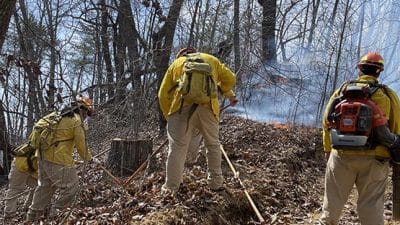The National Wildlife Federation today released a six-month progress report on the White House Climate Action Plan. The report assesses progress to date in five categories, detailing both steps forward so far and areas for improvement.
“President Obama laid out a bold plan to tackle climate change last June, a goal that’s critically important to saving wildlife and protecting our communities,” said Felice Stadler, senior director for climate and energy at the National Wildlife Federation. “We wanted to take a clear-eyed look at both the progress his administration has made in the six months since and what needs to be done going forward. For example, while the Obama administration has taken important steps toward limiting industrial carbon pollution, more must be done to keep high-carbon fuels in the ground on our nation’s public lands.”
The National Wildlife Federation graded progress using a qualitative scale from “poor” to “great” depending on actions taken to date to meet stated directives. In addition, the report includes five additional areas needing attention, highlighting topics not specifically covered in the administration’s plan that are critical to combat global warming.
“With 2013 going into the record books as the fourth-warmest year on record, if the state of our union is to remain strong, the call to action on climate change is more urgent than ever,” said Stadler.
LIMITING CARBON POLLUTION FROM INDUSTRY
Promise: The plan promises to cut carbon pollution from the nation’s fleet of power plants, using existing authority under the Clean Air Act. Progress: The Environmental Protection Agency (EPA) has re-proposed rules in January 2014 that would set carbon limits for any new coal plants being built in the U.S. They also appear to be on track to propose a draft carbon rule for existing power plants (due June 2014) . If finalized and implemented properly, these rules will significantly reduce carbon emissions from the largest polluting sector of the American economy, by incentivizing wildlife friendly clean energy development and energy efficiency as chief means of achieving carbon pollution reductions.
USING LANDS TO CURB CLIMATE POLLUTION
Promise: The plan promises to identify new approaches to protect and restore forests, grasslands and wetlands, to maximize their ability to store and absorb carbon pollution.
Progress: The Administration has welcomed input from forest stakeholders regarding priorities for expanding the carbon sequestration potential of U.S. forests, but this work is still in the early stages. On the grasslands front, the USDA’s Farm Service Agency released the first ever annual report of “new breakings” (showing how much virgin land had been brought into crop production for the first time) which helped illuminate how much and where native grassland destruction occurred in 2012. Yet despite USDA’s data showing alarming rates of grassland destruction, the U.S. EPA has still failed to implement the prohibition included in the Renewable Fuels Standard law which specifically proscribed fuels produced from crops grown on converted native grasslands from qualifying for the mandate. This is resulting not only in destruction of critical wildlife habitat, but also significant releases of carbon into the atmosphere which had been stored in these soils.
BETTER PREPARING FOR THE EFFECTS OF CLIMATE CHANGE

Progress: President Obama released an executive order on climate adaptation to accelerate national efforts to prepare for intensifying droughts, floods, storms, sea level rise and other climate change impacts. The order encourages cooperation across federal agencies, and across sectors, including private companies and NGOs. It also established a Task Force of state, local and tribal government leaders, which had its first meeting December 2013, to make recommendations to the President by November 2014 for how the federal government can support resilience activities. The Administration has also begun work, together with state and tribal partners, on implementing the recently released National Fish, Wildlife, and Plants Climate Adaptation Strategy. Federal funding for Hurricane Sandy recovery efforts are also being used to promote climate resilience, and take advantage of the protective functions offered by natural ecosystems.
INVESTING IN CLEAN RENEWABLE ENERGY

LEADING ON CLIMATE INTERNATIONALLY

AREAS NEEDING ATTENTION
Management of Public Lands: Our public forests, grasslands, and wetlands must be managed to better prepare for the impacts of climate change by using climate-smart conservation approaches to sequester carbon, and to promote wildlife-friendly renewable energy development. Troublingly, the Obama administration has strongly favored fossil fuel development over resource protection on our public lands, making these lands carbon pollution sources rather than sinks. Such policies also threaten to cancel out any climate gains through expansion of renewable energy on those same lands. To date, the Department of Interior has not presented a comprehensive strategy to reduce its greenhouse gas emissions, which should include the lands it owns and manages.
Coal and Oil Infrastructure Projects: The Keystone XL pipeline is pending President Obama’s decision, who has stated that he will only approve the pipeline if it doesn’t “significantly exacerbate the problem of carbon pollution”. This climate test should be applied to all pending fossil fuel infrastructure projects. In particular, climate change impacts should be assessed for other tar sands presidential permit applications (Enbridge Energy’s pending permit for its Midwest expansion and the anticipated permit for the New England Portland-Montreal pipeline). It should also be applied to the coal export facilities proposed in the Northwest. Further, the Council on Environmental Quality (CEQ) should direct all federal agencies to perform comprehensive National Environmental Policy Act (NEPA) analysis of new energy infrastructure projects that take into full account their projected greenhouse gas emissions and the direct and indirect impacts to wildlife and habitat.
Methane Pollution from Natural Gas: The natural gas boom on public, state, and private lands is a major contributor of methane pollution, a potent agent of climate change. The Department of Interior must continue to move aggressively to ensure methane pollution from gas development on public lands is accounted for and reduced. This effort must occur in tandem with initiatives by the EPA to reduce methane pollution from existing natural gas operations on public and private lands. The Administration has formed a multi-agency task force to look at methane emissions, but no signal has yet been given by the Administration that it will pursue regulatory action to reduce methane pollution from the natural gas industry.
International Trade and Finance: The President’s plan envisions the promotion of free trade in “environmental goods,” as well as enhanced engagement with other major economies on climate change. Care must be taken in these negotiations to avoid expanding free trade in sectors such as natural gas, which could clash with climate protection ambitions, or otherwise provide loopholes for trade that have negative climate impacts. For example, the U.S. is currently negotiating provisions in the Trans-Pacific Partnership (TPP) and Transatlantic Trade Investment Partnership (TTIP), which could weaken nations’ ability to pass climate and environmental regulations, such as on fracking, or facilitate expansion of commodity agriculture (such as palm oil) for export, thus causing deforestation.
Climate Change Education: As a nation we must educate, train and prepare every American for the opportunities of a new clean energy economy. We must ensure our nation’s workforce remains competitive and all Americans understand their role in reducing carbon pollution. We must especially prepare the next generation for the impact of climate change as it will affect their daily lives more than any generation before them. Unfortunately, the President’s Climate Action Plan completely ignores climate change education as a strategy to address climate change, and in fact, for the last two years the Administration has eliminated all environmental, climate and watershed education funding from its federal budget request to Congress for programs at NOAA and EPA. In future budget requests the Administration must restore and grow funding for these modest programs and embrace education as a key strategy to address climate change across federal agencies.
Related Resources











